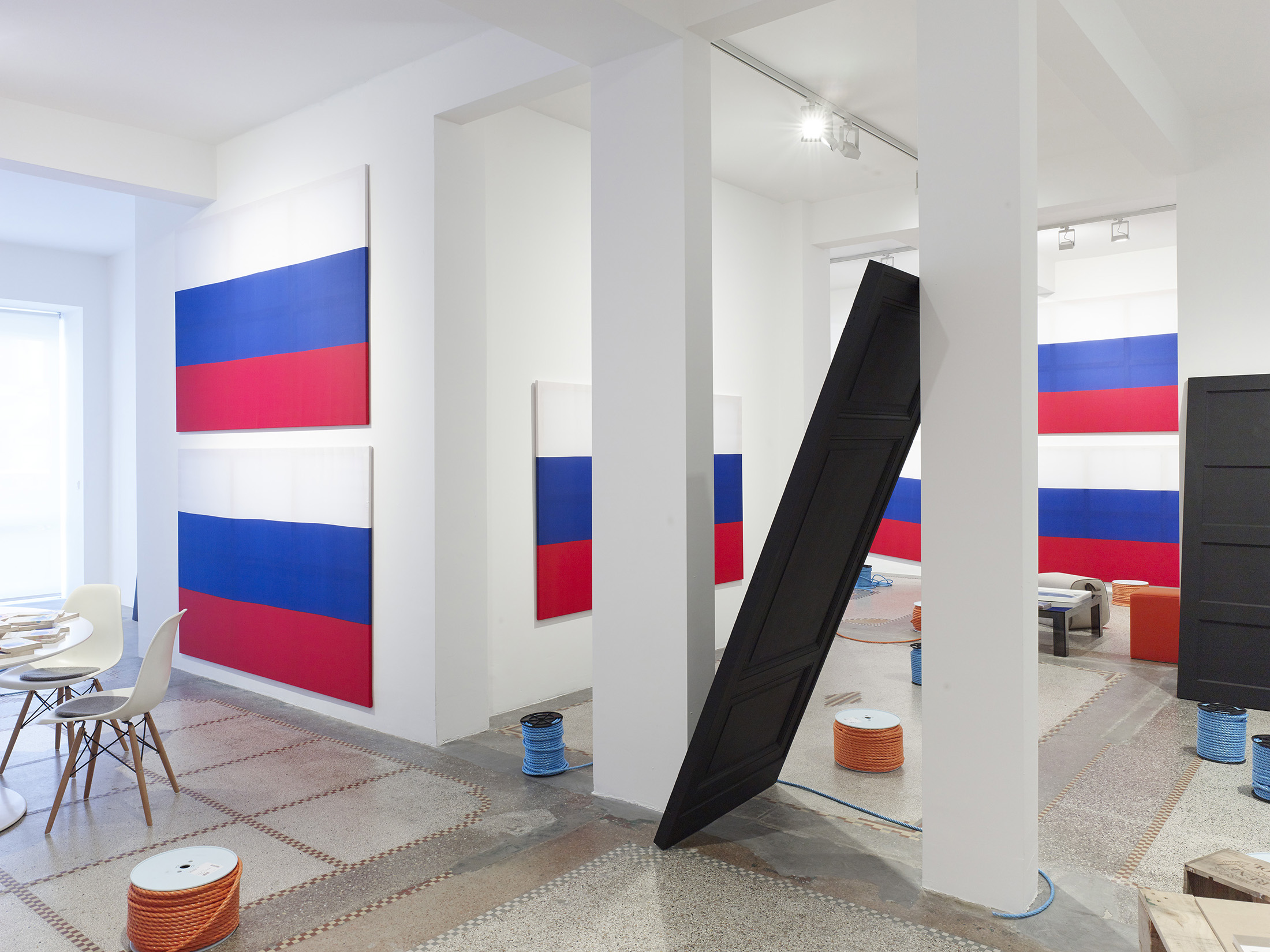one pic tuesday. Merlin Carpenter

MERLIN CARPENTER, Blogs Of The Near Future
installation view at dependance, Brussels
image courtesy the artist, dependance, Brussels
photo: KRISTIEN DAEM
–
MERLIN CARPENTER is currently having a solo presentation entitled Blogs Of The Near Future at the Belgian gallery dependance. Here is the entire press release:
People like Theresa May, Jeremy Corbyn, and also some Marxists suffer from an inability to read sudden Brexit-like shifts, looking for the reasons why only in deep content, and not seeing that the manifestation is also clearly a surface protest. And similarly I wonder whether they can deal with slower developments, such as an ideological drift which has cemented itself in the last 20-30 years, and does not by now tolerate heavy handed decisions with unintended consequences or cultural conservatism. This ideological drift of public opinion can develop despite or even because of restrictions on public debate (e.g. post-Snowden).
The artist, like ideology and reality in general, has an outer appearance as well as an inner intention at any given time. The best way to proceed from this is to keep the outer appearance and forget the intention. Meaning for the artist, judge her by what links every single project together, the general working practice over time, with all its compromise and pettiness. This is the meaning that develops between two shows, between two solutions; that which is not a solution.
In the study of ideology, similarly, you do not have to get through veils of distorted perception to get at the problem, because that distortion is itself the problem. Outwardly fetishised nonsense ideologies are symptoms of the inner capitalist contradiction.
In both cases it is a good idea to lay out the problem on the surface rather than trying to get behind it. Since we are dealing with misrecognition, it does not matter if the reading is not strictly correct. But in the process of “laying out” the surface of the ideology, actually something has changed, a minimal trace has been made in it. It has been secretly reversed, swapped for another version of itself.
Earlier this year I was picking through my previous artistic practice looking for a door into the point where it froze into error, and looking for what was going on between all the major gestures. I envisaged that I could see and make a truce with my own modus operandi and get behind it, “turn” it, move it around on its axis. But then something else happened, June 24th, ideology crossed me. As I was skating across in one direction, a perverted nationalism cut across my path from the other and stabbed me in the face. I had theorised an inflection point which then happened as a victory for the far right. It seemed like the entire UK was going through the same process as me but could only deal with the traumatic void by regressing into the past.
Is there something in this minimal “laying out” of ideology, which despite being theoretically adequate, actually offers itself up to the right? In my 2015 text “The Outside Can’t Go Outside” I used Manuel DeLanda’s “map of connection strengths” model as a proposal for social change. This model proposes an erasure of content in order to make a transition. But if any new content can be dumped in, isn’t that rather dangerous? The trace of the “map of connection strengths” is almost non-existent. But in the market as well, the invisibility of labour gives market ideology an inexistent quality, a naturalness. Both market and the minimal ideological inflection are fragile, tense 2D echo chambers in which any old ideas can bounce around. And it appears that there can be a kind of “turning of the inflection” from the opposite side.
Another context in which to examine this might be class struggle, also referenced in my longer 2015 text. Why has proletarian struggle failed to take on capitalism in recent years? First, there is no inherent revolutionary “working class consciousness,” in other words no automatic revolutionary programme. Meanwhile the worker is physically separated from others in the workplace and divided by race and nationality. But this “composition problem” of class struggle is also about the nature of the movement itself. Any struggle that has a specific demand cannot last; it must be a struggle that demands nothing, but also everything – with the realistic ambition of achieving it. So the struggle on the left is to just get the class struggle together.
But meanwhile there is another class struggle going on. The financial industry uses derivatives to even out risk between different investment possibilities. In order to gain access to these investments, each individual, corporation, or government has a credit rating or risk profile. On a national level the maintenance of this credit rating means reassuring a foreign investor that the State will clamp down hard on any working class disruption of production. The resulting estimation of the risk of every State (or other body) is a police action, it forces them to do things. This enables the continuous restructuring of labour on neoliberal lines. Both the eurozone’s actions toward Greece, and so-called Brexit, can be seen as the elite pulling the carpet from under people’s feet… a RULING class struggle.
The far right is less into class, but wallows in the different, and separate, ideology of nationalism. This declares the end of historical progress, which of course produces a violent shock. The Left must work on ideology in order to even “compose” an argument for a mass movement. This leaves a space for the racists to exploit, especially as they cannot grasp what is really at stake, the contradiction between capital and labour. People speak as if they are speaking to an empty space, but this space is being constructed by both sides, left and right. – press release
Blogs Of The Near Future by MERLIN CARPENTER is running through October 22, 2016.
–
comments are closed !